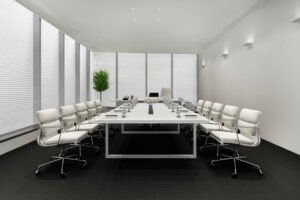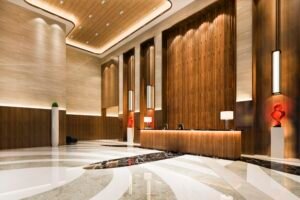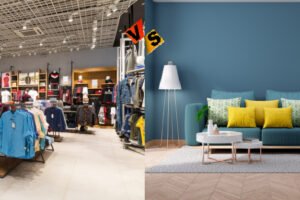
Elements of Commercial Interior Design
A Guide to the Elements of Commercial Interior Design
What is Commercial Interior designing?
Commercial interior designing as the name suggests refers to the designing of interiors in commercial spaces, like offices, retail buildings, hotel lobbies, banks, restaurants, and other public spaces. Designing the interiors for commercial spaces is quite a tricky business as there are various things to consider – the place must be cost-effective, practical, and efficient, and it should also generate a unique, pleasant, and engaging experience. All this must be done keeping the brand values and aspects intact, which is why a lot more thought goes into designing a commercial space.
We unconsciously tend to form a general impression about the design of any place that we visit, be it a shopping mall, museum, club, bar, hotel, casino, restaurant, theatre, or any other commercial space.

They are all well-structured and tailored to accommodate the guests’ needs as well as those of the industries they represent. Have you ever stopped to wonder how a certain place must have been planned and designed by the designers, why they chose to select a particular feature or to highlight a certain detail? Maybe now you can make a note of that the next time you visit a shopping mall, club, or even the bank, try to spot the commercial interior design aspects of that space.
Important elements of commercial interior designing
The designing process starts along with the construction phase but can be implemented only once the building has been constructed. The role of a commercial interior designer is to transform the physical structure into a living and pleasing space. They choose themes and styles that would suit the needs of the business as well as its users, and they bring about these aspects to life with finesse by referring to the important elements of commercial interior designing.
Space
Space is one of the most important elements of interior design as it lays the foundation on which the entire design plan is based. A commercial interior designer must be aware of the available amount of space, its dimensions, and the requirements based on which they can create a design plan.
The amount of space available varies from business to business and there is no one size fits all. Therefore, the designer must plan the design in such a way as to get the maximum out of the available space without compromising on its style. They must focus on functionality and safety without cutting down on style and aesthetics.

For example, A luxury hotel needs to accommodate a large number of guests to maximize profits, but to do so, the hotel has to offer lavish rooms and spacious bathrooms along with high-end amenities like gyms, pools, spas, etc. Keeping all of this in mind, the designer must plan the space in a balanced way.
Light
Lighting is an important element of commercial interior design as it has the ability to set the mood and ambience of a space. Lighting also affects the shape and size of an area and can make any place look larger than it is or a compact one. Light can be in the form of natural light that comes in from the windows, ventilators, or glass shields for a closed area or it can be directly flowing in if it’s an open area.
Artificial lighting is used to create various lighting effects in an area and is of different types like task lighting, accent lighting, and mood lighting which can be emitted through a variety of different sources. For example, A restaurant can be created with outdoor seating as well as indoor seating. During the day, the natural light may be sufficient for the outdoors, but the designer must plan the lighting to create a warm tone for the evenings under the sky.

Color and Patterns
Colors play a vital role in making the design come to life. Colors for most commercial spaces are chosen based on the company’s theme and patterns that they follow. The colors and patterns chosen for the interiors must represent what the company stands for and what kind of ambiance they want to provide to their customers, clients, or employees. Patterns are used to enhance the color scheme and are used to create a specific vibe. Interior designers study color schemes and color psychology to create a pattern that reflects the required theme – deep red tones are associated with passion and energy, while cool blue shades are viewed as calming and comfortable.
For example, restaurants like KFC and McDonalds use the red color to depict hunger, candy shops are usually pink and white to portray the innocence of children and bars use darker colors like grey, brown, golden to blend with the beverages.

Difference between commercial and residential interior designing
It might not seem significant to the common eye, but homes and commercial spaces are built differently and their design needs are also different. Residential interior designing focuses on designing homes and living spaces, while commercial interior designing conceptualizes spaces for businesses like hotels, banks, malls, offices, etc. Residential designing focuses on creating a welcoming and homely space for living in, while commercial designing focuses on functionality and style to make the area appealing to attract customers and offer them an engaging experience. Read about the latest interior design trends here.

Commercial interior designing includes designing for large luxurious resorts to designing for small retail outlets and offices. In any of the situations, a commercial interior designer has the responsibility to translate the client’s requirements to a design that is practical, functional, profitable, and smart.
Conclusion
A commercial interior designer can develop functional designs to suit special requirements by taking into account the correct blend of all the elements of commercial interior designing. It can be used to create and design well-equipped office buildings, fully-functioning manufacturing plants, themed restaurants, and multi-storeyed apartment complexes with equal proficiency.
Designers who work for commercial interiors may find the work quite challenging as every project comes with different levels of expectations, but it is also equally rewarding, both in terms of personal satisfaction and compensation to see your visualized and planned design come to life. It becomes essential to select designers with the right qualities and expertise.
We at Samruddhi, take care of all your interior design needs with our expertise at the best price.
Archives
Categories
- No categories


